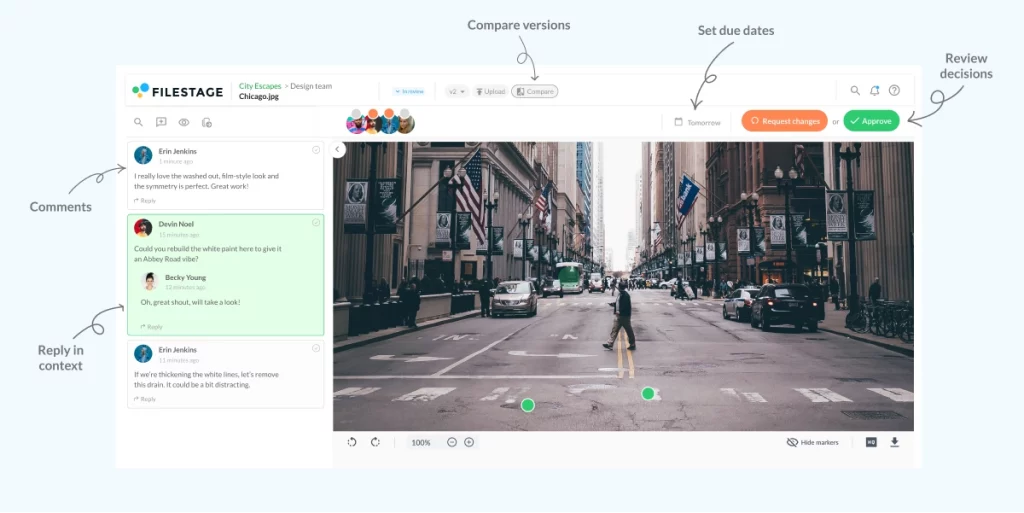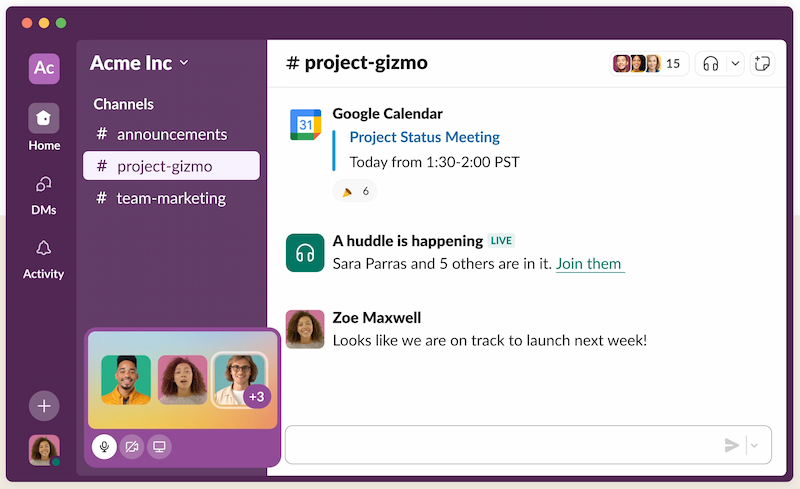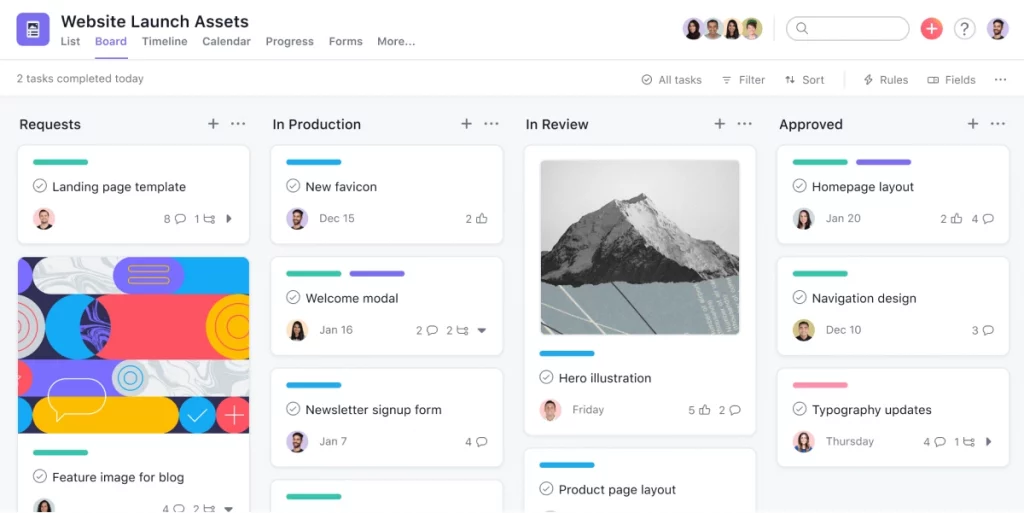Without collaborative working across teams, businesses will struggle to get projects over the line. And when the job does get done, team members will likely be stressed to the gills while the work itself will be subpar at best.
All in all, poor cross-team collaboration is never a good time. So, today I’m going to take you through everything you need to support cross-team collaboration in your business for the best results.
What is cross-team collaboration?
Cross-team collaboration, also known as cross-functional collaboration, refers to people from different departments within an organization (e.g. Strategists, Creatives, Account Managers, Marketing, and Sales teams) working together towards a shared goal.
Every marketing project demands a diverse set of skills, knowledge, and perspectives. So, the way individual teams work with one another is absolutely crucial to the success of your business.
Let’s look at some of the main gains that come from cross-team collaboration.
Faster problem-solving
Different teams bring new ideas and expertise to the table, which pave the way for more holistic and creative solutions to complex problems.
Boosted efficiency
Collaboration across teams helps businesses improve processes, reduce individual workloads, and use resources more effectively. This leads to higher productivity and cost savings.
Increased innovation
Combining ideas and skills from various teams sparks creativity and opens the door to innovative concepts, products, or services that would be almost impossible to find in isolation.
Higher job satisfaction
Cross-team collaboration makes work a whole lot more enjoyable for everyone involved by reducing conflict, creating a supportive work environment, and promoting a shared sense of purpose.
Supercharge your project collaboration
Share, review, and approve all your content in one place with Filestage.
Five steps for better cross-team collaboration on projects
Of course, every business and every project will be different. But there are a few core things you can do to improve the way your teams collaborate on projects.
Let’s look at the five practical steps for better cross-team collaboration!
Step one: Assign roles
When you have different teams working together, it’s important to minimize friction from the start by picking the right team members for the project at-hand.
Once you’ve put together a strong team, it’s time to assign roles. For example, outlining who needs to review the work at different stages will help rule out any misunderstanding and missed steps in the process.
Assigning experienced team leaders to manage cross-functional teams is also essential. Good team leaders will be able to delegate tasks to other team members, advise on next steps, and follow up on project progress to keep everything on track throughout.
Step two: Define a clear objective
Before you begin any project, big or small, every collaborator needs to understand the common end goal.
One way to agree on a shared goal is to focus on the problem you’re trying to solve as an organization, along with the opportunities you want to seize. Discussions between teams at this stage should be equally open and structured. This will help you explore different approaches and ideas while avoiding confusion or wasted time.
Each department will have different aims within a project, but the big picture should look the same for all. When everyone understands how their individual role aligns with broader organizational objectives, it will make for smoother cross-collaboration as the project moves along.
Step three: Be mindful of others’ schedules and capacity
It’s unlikely that your collaborators are working on one project only. But staying clued-up on everyone’s schedules and commitments will help minimize stress and keep projects moving. Respecting your coworkers’ time also goes a long way when it comes to creating a healthy work environment.
Before assigning tasks or scheduling meetings, take the time to inquire about each cross-functional team member’s availability and workload. Encourage open dialogue where team members feel comfortable expressing any concerns or constraints they may have.
Step four: Set clear timelines
We’ve all been there at some point. But there’s nothing worse than miscommunications about a project deadline that leave some team members scrambling to pick up the pieces.
You can nip this collaborative chaos in the bud by outlining timelines ahead of time, and updating teams if they change. Estimating key timelines before a project begins will make it easier for everyone to plan their time accordingly and finish their share of the work in time.
As projects progress, it’s oh-so important to agree on next steps and confirm with collaborators when they need to be completed. Staying crystal clear on timelines and how long each phase is expected to take will save a whole lot of stress down the line.
Step five: Choose the right collaboration tools
Cross-team collaboration is rarely a walk in the park, but remote teams and hybrid work environments can make things even more complicated. That’s why it’s important to choose the best virtual collaboration tools to support your teams and maintain transparency across entire projects.
Whether you need a shared space where team members can review and approve content, or you want a secure way to share large files, there are lots of great cross-team collaboration tools and platforms to help your teams collaborate and create the best work.
Let’s look at three top tools that can streamline your cross-team collaboration!
Filestage – best cross-team collaboration tool for fast approvals

Endless email chains. Missed feedback. Muddled-up file versions. Sound familiar? Without proper support, the cracks in your cross-team collaboration process can really start to show when reviewing content.
Filestage is an intuitive approval platform that takes the commotion out of reviewing files. It gives teams a single space to share and track files, discuss feedback, and reach final approval faster.
Key features
- Multiple file formats – review all popular file types, including videos, designs, documents, live websites, PDFs, and audio files
- Project dashboards – keep track of project progress and see who still needs to give feedback
- Due dates – meet deadlines with ease by setting due dates for your collaborators
- To-do lists – turn comments into actionable to-do lists so everyone knows what to do next
- Version history – stay up to date on previous comments, changes, and file versions at all times
- Reviewer groups – make sure files get approved by the right people at the right phase of your review process
Slack – best cross-team collaboration tool for clear communication

Slack is one of the most popular communication tools, used by teams across every industry, all over the world. It allows for seamless real-time communication through instant messaging, videos calls, Huddles, and more. This makes it the perfect platform to enhance cross-team collaboration in your business.
Key features
- Direct messages – ask questions, discuss topics, share information with individual team members or groups in real time
- Channels – create a dedicated space to communicate about specific topics or projects
- File sharing – share files from your desktop or other applications with just a couple clicks
- Search – use the platform’s search bar to look for past messages and files
- Integrations – Slack integrates with a variety of other platforms, like Google Drive, Dropbox, and Salesforce
Asana – best cross-team collaboration tool for managing projects

It’s almost impossible to collaborate effectively on a project without proper organization and planning. This is where project management software like Asana comes in handy.
No matter the size of your project, Asana makes it easier to facilitate cross-team collaboration by allocating resources, planning out project workflows, and tracking progress. The tool can be used to keep every team on the same page by creating subtasks, setting timelines, and adding comments.
Key features
- Project management – create projects, organize specific tasks within projects, assign roles, and set due dates on a single shared platform
- Comments – communicate instantly with team members using tags and real-time comments under each task
- Reporting – automatically generate reports for information on task progress and how much time is spent on different tasks
- Integrations – Asana integrates with a variety of other apps, such as Google Drive, Salesforce, and Slack for a smoother workflow
Six extra tips to create a more collaborative work environment
Alright, we’ve explored the practical steps for improving cross-team collaboration on a project, as well as some of the best tools to bring teams together. Now, I thought it would be helpful to share some more general tips and tricks for creating a collaborative day-to-day work environment between teams.
Let’s go!
1. Embed collaboration into company culture
All the tools and processes in the world won’t do much to improve cross-team collaboration if you don’t have a collaborative culture to match.
A collaborative culture is one where teams work together seamlessly, leveraging diverse skills and perspectives to achieve common goals. It emphasizes the value of teamwork and provides the necessary support and resources that give teams insight into the role of different departments within the business for more empathy and understanding.
By nurturing a culture where cross-functional team collaboration is celebrated and ingrained into your organization’s DNA, it will make cross-team collaboration on projects a much smoother process.
2. Limit team meetings
More meetings do not make for better cross-team collaboration. I repeat. More meetings DO NOT make for better cross-team collaboration.
While meetings and catch-ups are useful, excessive meetings will actually hinder productivity and collaboration by taking time away from the work itself. Plus, the time it takes to constantly navigate teammates’ schedules to find a time that works for everyone is not worth it.
As a rule of thumb, keep meetings for the key stages of your creative process. You can then opt for communication and collaboration tools that keep work flowing without unnecessary interruptions.
3. Provide training and development
Workshops and training can go a long way when it comes to fostering cross-team collaboration, too.
It’s a good idea to offer employees training programs that focus on collaboration skills, such as effective communication, conflict resolution, and teamwork. Give teams the tools to collaborate effectively from the start to promote a positive, solution-focused approach to every project.
4. Give teams the time to collaborate
Teams need the time and space to get their head into the brief and share their ideas with the group.
It sounds simple, but all too often, teams are rushed to settle and start developing an idea before everyone’s had the chance to have their say. This not only takes away from job satisfaction, it also means that valuable ideas go unseen due to time constraints.
When planning projects, it’s crucial to allocate as much time as possible for brainstorms and collaborative decision-making.
5. Measure and share team performance
Implement regular check-ins where each team reports on their assigned key performance indicators (KPIs). This creates a sense of accountability and transparency while helping teams acknowledge areas that may need improvement.
By clearly defining responsibilities, setting specific goals, and establishing regular check-in times, cross-team collaboration becomes more productive and aligned with overall objectives.
6. Invest in team building activities
Effective cross-team collaboration requires trust and openness among team members. Team building activities can be a great way to achieve this.
Team building activities, like challenges and competitions, help everyone get to know each other better and build stronger relationships. They also boost morale, reduce conflicts, and improve overall teamwork.
By investing in team building, you can create a more positive work environment where teams work together smoothly and achieve better results.
Final thoughts
When taking on any project, teamwork definitely makes the dream work. While cross-collaboration between teams takes some extra time and consideration, the boost in team morale and the higher quality work will make it all worthwhile!
Hopefully this article has given you the confidence to help the teams in your business collaborate more effectively across projects and beyond. And if you’d like to see how Filestage can transform the way your marketing team reviews and approves content, start your free trial today.








